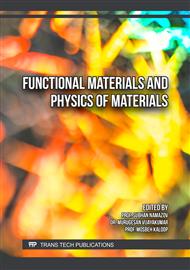[1]
Cahit Demetgul, Muruvvetkarakaplan, Selahattunserin and Metindigrak "Synthesis, Characterization, and biological properties of Ni(II), Co(II), and Cu(II) complexes of Schiff bases derived from 4-aminobenzylamine", J. Coord. Chem,62(1), (2009) 3544-3551.
DOI: 10.1080/00958970903082192
Google Scholar
[2]
Mahmoud WH, Deghadi RG, Mohamed GG. "Novel Schiff base ligand and its metal complexes with some transition elements.Synthesis, spectroscopic, thermal analysis, antimicrobial and in vitro anticancer activity", Appl. Organomet. Chem. 30(4),(2016) 221–230.
DOI: 10.1002/aoc.3420
Google Scholar
[3]
Majumder A, Rosair GM, Mallick A, Chattopadhyay N, Mitra S Synthesis, structures and fluorescence of nickel, zinc and cadmium complexes with the N, N, and O-tridentate Schiff base N-2-pyridylmethylidene-2-hydroxy-phenylamine. Polyhedron 25(8), (2006) 1753–1762.
DOI: 10.1016/j.poly.2005.11.029
Google Scholar
[4]
Basak S, Sen S, Marschner C, Baumgartner J, Batten SR, Turner DR, Mitra S ." Synthesis, crystal structures and fluorescence properties of two new di-and polynuclear Cd (II) complexes with N2O donor set of a tridentate Schiff base ligand", Polyhedron 27(4), (2008) 1193–1200.
DOI: 10.1016/j.poly.2007.12.005
Google Scholar
[5]
Qian S-S, Zhang M, Wang Y-N, Tian F-Y, Liu L, You Z-L, Zhu H-L ," Synthesis, crystal structures, and fluorescent properties of zinc and cadmium (II) complexes with tridentate Schiff bases" J. Coord. Chem, 66(6), (2013) 1006–1015.
DOI: 10.1080/00958972.2013.773980
Google Scholar
[6]
Armaroli, G. Accorsi, F. Cardinali, A. Listorti, Photochemistry and photophysics of coordination compounds: copper, in: V. Balzani, S. Campagna (Eds.), " Photochemistry and Photophysics of Coordination Compounds I", Springer, Berlin/Heidelberg, 69e115,(2007).
DOI: 10.1007/128_2007_128
Google Scholar
[7]
Grybauskaite-Kaminskiene, K. Ivaniuk, G. Bagdziunas, P. Turyk,P. Stakhira, G. Baryshnikov, D. Volyniuk, V. Cherpak, B. Minaev, Z. Hotra,H. Ågren, J.V. Grazulevicius, "Contribution of TADF and exciplex emission for efficient "warm-white" OLEDs ".J. Mater. Chem. 6, (2018), 1543-1550.
DOI: 10.1039/c7tc05392d
Google Scholar
[8]
Hu, M.Y. Gao, T. Wen, Y. Kang, S. Chen,( Inorganic Chemistry 56.6507e6511,(2017).
Google Scholar
[9]
Chacko, H. Boshoff, V. Singh, D.M. Ferraris, D.R. Gollapalli, M. J Zhang, A. P Lawson, M. J Pepi, A. Joachimiak, M. Rizzi, V. Mizrahi, G. D Cuny, L. Hedstrom," Targeting Genome Integrity in Mycobacterium Tuberculosis: From Nucleotide Synthesis to DNA Replication and Repair ",Molecules, 25(5), (2020) 1205.
DOI: 10.3390/molecules25051205
Google Scholar
[10]
Nishikawa, K. Nomoto, S. Kume, K. Inoue, M. Sakai, M. Fuji, H.J. Nishihara, "Dual emission caused by ring inversion isomerization of a 4-methyl-2-pyridyl-pyrimidine copper (I) complex", Am. Chem. Soc. 132, (2010), 28, 9579–9581
DOI: 10.1021/ja103718e
Google Scholar
[11]
Smita Ghosh,Vithal A Kawade, Avinash V Sapre and Avinash S Kumbhar.,"ulse Radiolytic Studies On Ci S-Dichlorobis(1,10-Phenanthroline-,6-Dione)Cobalt(III) Complex", Journal Chemical Science, 22, (2), (2010) 225–232.
DOI: 10.1007/s12039-010-0026-7
Google Scholar
[12]
Tsuboyama,A.,et al."HomolepticCyclometalated Iridium Complexes with Highly Efficient Red Phosphorescence and Application to Organic Light-Emitting Diode. Journal of the American Chemical Society", 125(42), (2007), 12971-12979.
DOI: 10.1021/ja034732d
Google Scholar
[13]
Akine, T. Taniguchi, W. Dong, S. Masubuchi, T. Nabeshima., "Helical Metallohost−Guest Complexes via Site-Selective Transmetalation of Homotrinuclear Complexes", J. Am. Chem. Soc. 128, 49, (2006),15765–15774
DOI: 10.1021/ja0646702
Google Scholar
[14]
Alizadeh, K.; Parooi, R.; Hashemi, P.; Rezaei, B.; Ganjali, M.R. (2011). A new Schiff's base ligand immobilized agarose membrane optical sensor for selective monitoring of mercury ion. Journal Hazard Mater. 186, (2011), 1794–1800.
DOI: 10.1016/j.jhazmat.2010.12.067
Google Scholar
[15]
Jeong, U.; Kim, Y "Colorimetric detection of heavy metal ions using aminosilane". Joural of Indian English Chemistry. 31, (2015) ,393–396..
DOI: 10.1016/j.jiec.2015.07.014
Google Scholar
[16]
Silverstein,D. and Webster, M., "Spectrometric Identification of Organic Compounds" 7th Edition. John Wiley & Sons, Inc., (2005) USA.
Google Scholar
[17]
Hu F L, Yin X H, Mi Y, Zhang S S, Luo W Q., "Synthesis, characterization and luminescence properties of Eu(III) and Tb(III) complexes with novel pyrazole derivatives and 1,10-phenanthroline" Spectrochem. Acta, Part A,75(2), (2010) 825.
DOI: 10.1016/j.saa.2009.12.006
Google Scholar



